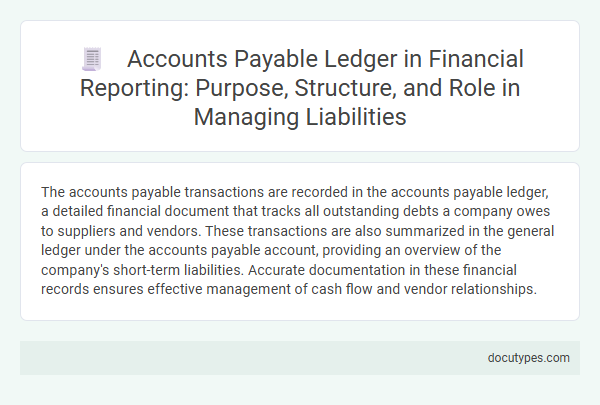The accounts payable transactions are recorded in the accounts payable ledger, a detailed financial document that tracks all outstanding debts a company owes to suppliers and vendors. These transactions are also summarized in the general ledger under the accounts payable account, providing an overview of the company's short-term liabilities. Accurate documentation in these financial records ensures effective management of cash flow and vendor relationships.
Introduction to Accounts Payable Ledger in Finance
The accounts payable ledger is a critical financial document that records all transactions related to a company's outstanding debts to suppliers and creditors. Understanding this ledger allows you to track your obligations and manage cash flow effectively.
- Accounts Payable Ledger Definition - It is a detailed record of all amounts a business owes to its suppliers for goods and services received on credit.
- Transaction Recording - Each accounts payable transaction, including invoices and payments, is systematically entered into the ledger to maintain accurate financial tracking.
- Financial Impact - The ledger is essential for preparing financial statements, as it reflects short-term liabilities that affect the company's balance sheet and liquidity.
Purpose of the Accounts Payable Ledger in Organizations
The financial document that records accounts payable transactions is the Accounts Payable Ledger. This ledger details all amounts a company owes to its suppliers and creditors for goods and services received.
The purpose of the Accounts Payable Ledger in organizations is to track outstanding obligations accurately and ensure timely payments. Maintaining this ledger helps manage cash flow, avoid late fees, and maintain strong supplier relationships.
Structure and Key Components of an Accounts Payable Ledger
The financial document that records accounts payable transactions is the Accounts Payable Ledger. It provides a detailed record of all amounts owed by a company to its suppliers and creditors.
- Entry Details - Each transaction includes the invoice number, date, and vendor name to track the source and timing of the payable.
- Transaction Amounts - The ledger records the original amount, any payments made, and the outstanding balance for clear financial management.
- Payment Terms and Due Dates - Terms and due dates are documented to monitor payment deadlines and maintain healthy vendor relationships.
Recording Transactions in the Accounts Payable Ledger
The financial document that records accounts payable transactions is the Accounts Payable Ledger. This ledger maintains detailed information on amounts owed to suppliers and vendors for goods and services received.
Recording transactions in the accounts payable ledger ensures accurate tracking of outstanding liabilities. You can monitor payment due dates and manage cash flow effectively through this detailed documentation.
Integration of Accounts Payable Ledger with Financial Reporting
The financial document that records accounts payable transactions is the Accounts Payable Ledger. This ledger integrates directly with your company's financial reporting, providing accurate and up-to-date information on liabilities. Seamless integration ensures that accounts payable balances are reflected correctly in the balance sheet and cash flow statements for precise financial analysis.
Role of Accounts Payable Ledger in Liability Management
The accounts payable ledger is the primary financial document that records all accounts payable transactions. It details amounts a business owes to suppliers and creditors, serving as a critical tool for tracking outstanding liabilities.
The accounts payable ledger plays a crucial role in liability management by providing an organized record of short-term debts. It helps finance teams monitor payment due dates, manage cash flow, and prevent late fees. Accurate maintenance of this ledger ensures reliable financial reporting and supports effective budget planning.
Internal Controls for Accurate Accounts Payable Reporting
Which financial document records accounts payable transactions? The accounts payable ledger is the primary financial document that records all accounts payable transactions. Robust internal controls within this ledger ensure accurate tracking and prevent misstatements in financial reporting.
Common Challenges in Managing Accounts Payable Ledgers
| Financial Document | Description | Common Challenges in Managing Accounts Payable Ledgers |
|---|---|---|
| Accounts Payable Ledger | The accounts payable ledger is the primary financial document that records all transactions related to amounts a company owes its suppliers or vendors. It tracks invoices received, payments made, and outstanding balances. | Maintaining accuracy in the accounts payable ledger can be difficult due to frequent invoice discrepancies, delayed supplier payments, and challenges related to matching purchase orders with invoices. Data entry errors and incomplete documentation may cause reconciliation issues. Inefficient ledger management can lead to cash flow problems and damage vendor relationships. You need to implement systematic tracking and verification processes to reduce these challenges and ensure reliable financial reporting. |
Best Practices for Maintaining an Accurate Accounts Payable Ledger
The accounts payable ledger is the primary financial document that records all accounts payable transactions. Maintaining an accurate accounts payable ledger ensures proper tracking of company liabilities and supports effective cash flow management.
- Timely Recording - Enter all invoices and payment details promptly to avoid discrepancies and ensure up-to-date financial information.
- Regular Reconciliation - Reconcile the accounts payable ledger with supplier statements each month to identify and resolve any inconsistencies.
- Segregation of Duties - Implement clear roles for invoice approval, payment processing, and ledger maintenance to prevent errors and fraud.
Consistent adherence to these best practices enhances the reliability of financial reporting and supports sound decision-making.
Which Financial Document Records Accounts Payable Transactions? Infographic

